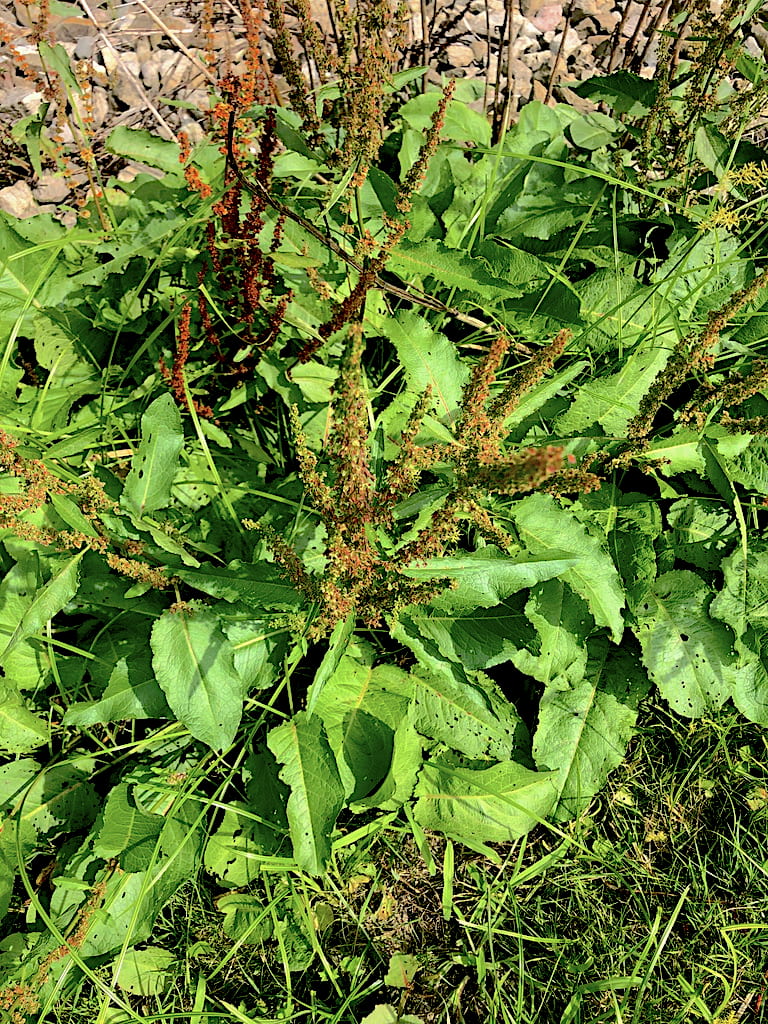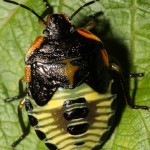
Synopsis: Over the past week stink bug have begun feeding on tree fruit, albeit in low numbers along the orchard perimeter.
The two native species including the native green stink bug (GSB), Acrosternum hilare (Say) and brown stink bug (BSB) (Euschistus servus) (Hemiptera: Pentatomidae) have been moving from deciduous forest trees and broadleaf border plants to tree fruit,
feeding on apple in some orchard blocks across the region.
In early August we began to see the very wet July conditions (7.05″ New Paltz, NY) begin to dry down some. In drier locations and well drained sites, this has lead to weed plants under drought conditions, leading to movement to fruit and feeding from the stink bug complex. Injury is just now beginning to appear in Ulster and Orange County orchard blocks.
In only two Hudson Valley sites in Ulster and Orange County have we have seen feeding that may warrant pest management. These were border trees near weed host plants. We are recommending intensive boarder scouting. Upon finding stink bug adults or nymphs on orchard trees, management should begin along the edges bordering woodland and weed hosts.


Overview: The green stink bug and brown marmorated stink bug are arboreal insects, residing in woodland tree hosts. As host resources decline they tend to move to agricultural crops, often during drought conditions. In general stink bugs have become a late season challenge to integrated pest management programs requiring the use of broad-spectrum insecticides in the organophosphate, carbamate, and pyrethroid class of chemistry to provide effective management of the pest.
The neonicotinoid class is considered a reduced risk group of insecticides to replace the organophosphate class for pest management. One of the more effective insecticides in this group, Dinotefuran, has been found to be very effective in managing the stink bug complex. Yet the product not yet been allowed by DEC to receive a NYS label or Section 18 for use on tree fruit against the stink bug complex.
An alternative pest management tool in place of the older classes of insecticides is the neonicotinoid, Actara. Actara (A.I. Thiamethoxam) has conservative 35 DTH and A.I. per acre restrictions. In New York State, do not exceed 0.172 lb. a.i./A (11 oz.) of Actara or thiamethoxam containing products per acre per growing season on Pome Fruit.


In light of these restrictions, the use of the pyrethroids Bifenthrin (Bifenthure, Brigade) are available as a Section 18 with labels.
Fenpropathrin (Danitol) also has excellent efficacy against the SB complex and is relatively ‘user friendly’ with lower mammalian toxicity. However, the pyrethroids impose greater reduction of biological control agents such as the predatory mite T. pyri and predaceous beetle complex, that may lead to mite flare-up late in the season.
What to do within 7 days to harvest
Keeping BMSB from feeding on the fruit is at the crux of our stink bug management program as we near harvest. Killing the insect as it moves into the orchard and onto the fruit is the traditional method of crop protection and proven to be very effective. Yet limitations, based on the material pre-harvest intervals constrain their use near harvest. There are no effective pyrethroids, neonicotinoids or pre-mixed insecticide tools that permit their use within the 7-day to harvest window with very few options available during the days prior to fruit harvest.
A Novel Mode of Action: The development of newer classes of insecticides that produce an anti-feeding response in the pest provides an additional mode of action for BMSB management. Both Corteva insecticide Closer 240 SC (classified as a Group 4C insecticide / neonicotinoid – 7 DTH) and Venerate XC (microbial-based insecticide with multiple modes of action and 0 DTH) have anti-feeding activity against BMSB. The 0 DTH of Venerate provides BMSB management up to the day of harvest under high risk conditions.
More resources for management of the stink bug complex can be found here.

